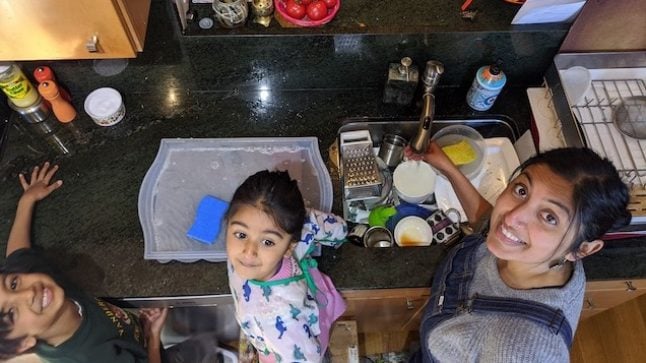Serie: Ideas at Work
Sirviendo las matemáticas: Las tareas en casa pueden convertirse en tiempo para las matemáticas

Every day dishes need to get cleaned, and every day dishes need to get put away. It might not seem like an important task… until there are no spoons for your morning cereal! By involving children in chores like doing the dishes, you can help them see mathematics in the work and turn an everyday task into a math task. And even better if you get some help in everyday chores around the house!
Enough is Enough – Measurement
Hay muchas comparaciones diferentes que aparecen durante la experiencia de lavar los trastes. Eso quiere decir que hay buena oportunidad de presentar lenguaje relacionado con las medidas mientras que los chicos ya se encuentran involucrados.
Essentially, any time you talk about amount – how much, whether more or less would be better, which is smaller—you are talking about math relationships. Just noticing these opportunities and using language to point them out really mathematizes the dishes!
Mother and daughter compare sizes of “baby spoons” and “daddy spoons” in their home language, Gujarati.
Algunos ejemplos son:
- Organizing which dishes will be washed first: “We’ll start with the little things, like utensils, and save the big things for last.”
- Explaining how you decide how much water to put in your sink or basin: “Let’s fill it right up to that line—that’ll be enough for the pans to get soaked.”
- Deciding how much dish soap to use: “If we use too much, the bubbles will get all over and we won’t have enough left for tomorrow.”
- Putting dishes away: “The short spoons go in this tray, and the long spoons go in that one.”
Give your Dishes a Spin! – Spatial Relationships
It’s also true that most of the dishwashing task is consumed with moving objects around. To do that effectively, we all make judgements about whether there is “enough room” and we rotate and flip objects to clean and organize them. This kind of pensamiento geométrico sino ha sido demostrado que se conecta a muchos diferentes tipos de tareas matemáticas.
Singing makes chores a lot more fun! Use a familiar tune and sing as you work. Here’s a song in Gujarati.
He aquí algunas de las oportunidades que podrían verse:
- Bringing all the dishes from the table to the counter next to the sink: “Let’s stack the plates on top of each other here, right next to the bowl.”
- Loading the dishwasher: “Put the forks with the tines up, like this, so they have a better chance to get clean.”
- Hand-washing the cups: “It’s good for you to get the cloth all the way down inside the cup to the bottom to get all the milk out.”
- Putting dishes away: “The pot lids go in the drawer under the microwave.”
Organizarse para el Èxito
Just a reminder to be patient the first time you try involving your kids in cleaning up the kitchen. Start small and give little ones ample time. It might take you 10 minutes to complete the task on your own and 20 minutes or longer with your children but trust that process will get easier. Plan on sticking around to share the work – children will need your support and your supervision. When you layer in math language about size and spatial relationships, then your dish-washing does double duty. Clean dishes AND math learning: a win-win situation!
Cuando añade el lenguaje matemático acerca de las comparaciones de tamaño y las relaciones espaciales, su sesión de lavado de trastes hace trabajo doble. Trastes limpios Y aprendizaje de matemáticas: ¡Una ganancia doble!